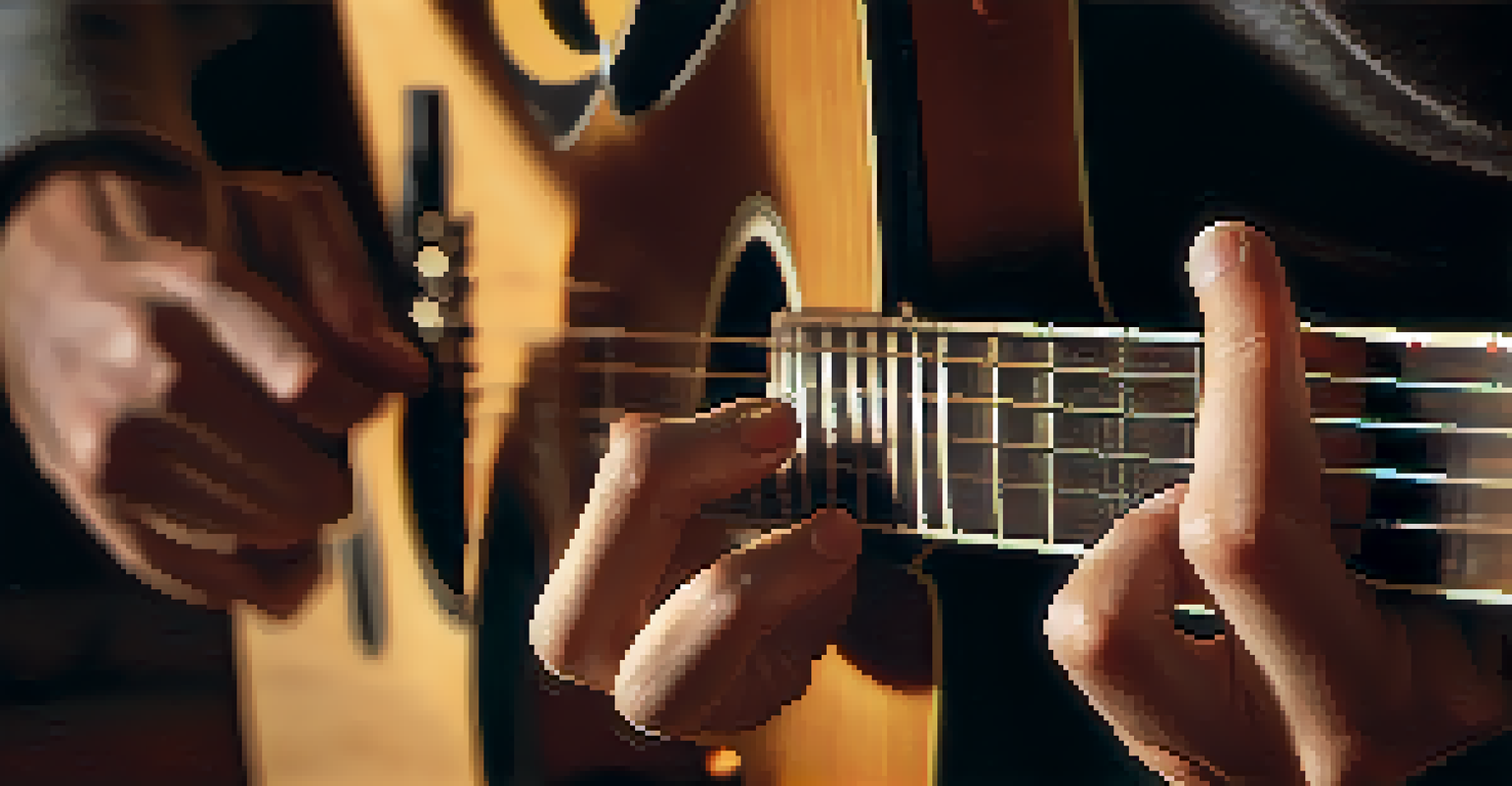Melody and Emotion: Crafting Emotional Melodies on Guitar

Understanding the Connection Between Melody and Emotion
Melody is more than just a sequence of notes; it's a powerful tool for expressing emotion. Think of your favorite song—chances are its melody resonates with you on a deeper level, stirring feelings that words alone can’t convey. Whether it's a joyous tune or a somber ballad, each melody has the potential to evoke a wide range of emotions.
Music can change the world because it can change people.
When you play a melody on the guitar, you’re not just producing sound; you're telling a story. This narrative aspect of music allows listeners to connect with the emotions being conveyed. By understanding how different notes and rhythms affect feelings, you can create melodies that resonate with your audience.
Ultimately, the beauty of melody lies in its ability to transcend language and culture. For instance, a simple ascending scale can evoke hope, while descending notes might bring about sadness. Recognizing this connection is the first step in crafting emotional melodies that truly speak to the heart.
Choosing the Right Scale for Emotional Impact
The scale you choose plays a crucial role in setting the emotional tone of your melody. Major scales are often associated with happiness and brightness, while minor scales tend to evoke feelings of sadness or introspection. By selecting the appropriate scale, you can significantly enhance the emotional quality of your music.

For example, the C major scale has a cheerful and uplifting sound, making it ideal for creating joyful melodies. On the other hand, the A minor scale carries a more melancholic vibe, perfect for ballads that tug at the heartstrings. Experimenting with different scales can lead you to discover unique emotional landscapes.
Melody Evokes Deep Emotions
Melody serves as a powerful means of expressing emotions that resonate on a profound level, often without the need for words.
Additionally, don’t shy away from modes, which can add even more flavor to your melodies. The Dorian mode, for instance, strikes a balance between major and minor, creating a sound that feels both hopeful and reflective. By understanding how different scales and modes influence emotion, you can craft melodies that resonate deeply with your listeners.
Utilizing Dynamics to Enhance Emotional Expression
Dynamics refer to the variations in loudness and intensity of your playing, and they are key to conveying emotion. A soft, whispering note can evoke vulnerability, while a powerful strum can express joy or anger. By varying your dynamics, you can create a more engaging and emotional experience for your audience.
The beautiful thing about music is that it transcends language.
For instance, think about how a gentle picking pattern might convey a sense of intimacy, while a sudden loud chord can create excitement or surprise. This interplay between soft and loud can guide your listeners through a rollercoaster of emotions, much like a compelling story.
Incorporating dynamics into your melodies not only keeps the listener's attention but also enhances the emotional depth of your music. As you practice, experiment with different levels of intensity and notice how they affect the feel of your playing. This exploration can lead to more powerful and emotionally resonant melodies.
Melodic Phrasing: The Art of Timing and Expression
Melodic phrasing is all about how you shape and deliver your notes over time. Just like in spoken language, where pauses and emphasis can change the meaning of a sentence, phrasing in music can evoke different emotions. A well-placed pause can create suspense, while a fluid, connected line can express longing.
Consider the difference between playing notes in a straight, robotic manner versus adding subtle bends and slides. These techniques can make your melody feel more alive and expressive. By paying attention to how you phrase your melodies, you can enhance their emotional impact.
Scales Shape Emotional Tone
Choosing the right musical scale significantly influences the emotional impact of your melody, with major scales conveying happiness and minor scales evoking sadness.
Listening to great guitarists can provide insight into effective phrasing. Notice how they use timing and articulation to convey emotion, and try to incorporate similar techniques into your playing. Remember, it’s not just about the notes you play, but how you play them that makes all the difference.
Incorporating Chord Progressions for Emotional Depth
Chord progressions are the backbone of most songs and play a significant role in shaping the emotional landscape. A well-chosen progression can enhance the emotional quality of your melody, creating a richer listening experience. For example, a progression that moves from a minor chord to a major chord can evoke a sense of resolution or hope.
Consider classic progressions like the I-IV-V or vi-IV-I-V, which have been used in countless songs to evoke specific feelings. By experimenting with different progressions, you can find combinations that elevate the emotional tone of your melodies. Each chord carries its own emotional weight, so choose wisely to match the feelings you wish to convey.
Additionally, incorporating unexpected chord changes can surprise your listeners and deepen their emotional engagement. A sudden shift in tonality or rhythm can create tension and release, much like a plot twist in a good story. By thoughtfully integrating chord progressions into your melodies, you can craft a more compelling emotional narrative.
Expressing Emotion Through Guitar Techniques
Techniques like fingerpicking, slides, and hammer-ons can add emotional nuance to your melodies. Each technique brings its own character and feel, allowing you to express a wide range of emotions. For instance, fingerpicking can create a delicate, introspective sound, while strumming can convey a sense of urgency or excitement.
Think about how a slide can effortlessly move between notes, creating a smooth and emotional transition that resonates with the listener. Similarly, hammer-ons can add a sense of strength and confidence to your playing. By incorporating these techniques, you can infuse your melodies with personality and emotion.
Techniques Enhance Emotional Nuance
Guitar techniques like fingerpicking and slides add emotional depth to melodies, allowing for a more expressive musical experience.
As you explore different guitar techniques, pay attention to how they alter the emotional quality of your sound. Each technique has its own unique flavor, and by mastering them, you can create melodies that truly reflect your feelings and experiences.
Finding Your Unique Voice in Emotional Melodies
As you develop your skills in crafting emotional melodies, it's vital to find your unique voice. Every guitarist has a distinctive style that reflects their personality and experiences. Embrace your individuality, and don't be afraid to experiment with different genres, techniques, and approaches to melody writing.
Drawing inspiration from various artists can help you discover your sound. Listen to how they express emotion through their melodies and consider what resonates with you. You can take elements from different styles and combine them to create something fresh and personal.

Ultimately, the journey of finding your unique voice is ongoing. As you continue to practice and evolve, your emotional melodies will become a true reflection of who you are as a musician. Remember, authenticity is key, and your personal touch will make your music truly special.